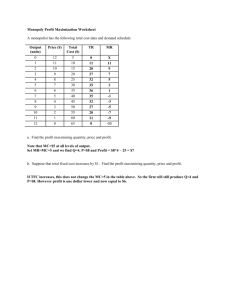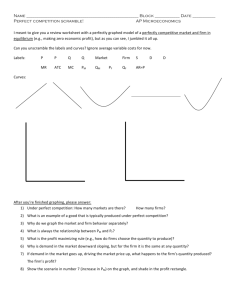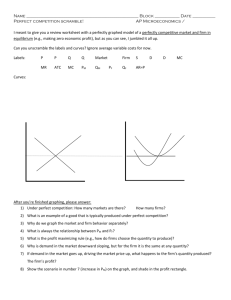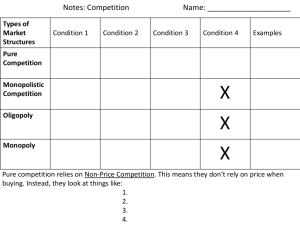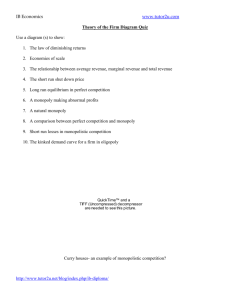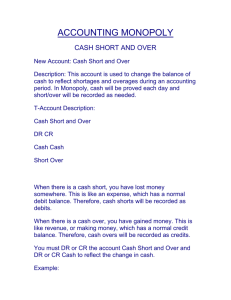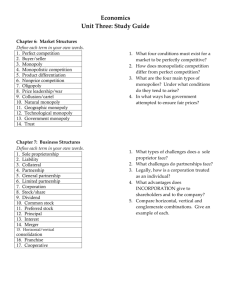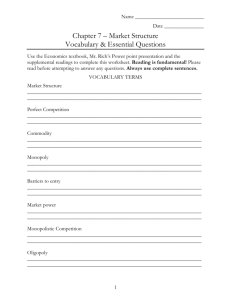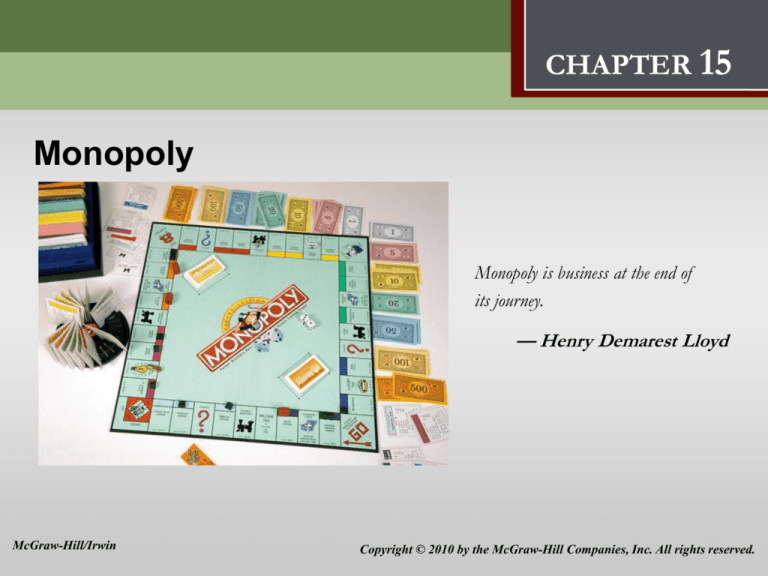
Monopoly
15
CHAPTER 15
Monopoly
Monopoly is business at the end of
its journey.
— Henry Demarest Lloyd
McGraw-Hill/Irwin
Copyright © 2010 by the McGraw-Hill Companies, Inc. All rights reserved.
Monopoly
15
Chapter Goals
• Summarize how and why the decisions facing a
monopolist differ from the collective decisions of
competing firms
• Explain why MR = MC maximizes total profit for a
monopolist
• Determine a monopolist’s price, output, and profit
graphically and numerically
15-2
Monopoly
15
Chapter Goals
• Show graphically the welfare loss from monopoly
• Explain why a price-discriminating monopolist will
earn more profit than a normal monopolist
• Explain why there would be no monopoly without
barriers to entry
• Discuss three normative arguments against monopoly
15-3
Monopoly
15
A Monopolistic Market
• Monopoly is a market structure in which one firm makes up
the entire market
• Barriers to entry into the market prevent competition
• Barriers to entry can be:
• Legal
• Sociological
• Natural
• Technological
• There are no close substitutes for the monopolist’s product
15-4
Monopoly
15
The Key Difference
Between a Monopolist and a Perfect Competitor
• A monopolistic firm’s marginal revenue is not its price
• Marginal revenue is always below its price
• Marginal revenue changes as output changes
and is not equal to the price
• A monopolistic firm’s output decision can affect price
• There is no competition in monopolistic markets so
monopolists see to it that monopolists, not consumers,
benefit
15-5
Monopoly
15
Profit Maximizing Level of Output
• The goal of the monopolistic firm is to maximize profits,
the difference between total revenue and total cost
• The monopoly maximizes profit when marginal revenue
equals marginal cost
• Marginal revenue (MR) is the change in total revenue
associated with a change in quantity
• Marginal cost (MC) is the change in total cost associated
with a change in quantity
15-6
Monopoly
15
Profit Maximizing Level of Output
• The profit-maximizing condition of a monopolistic firm is:
MR = MC
• For a monopolistic firm, MR < P
• A monopolistic firm maximizes total profit, not profit per unit
If MR > MC,
• The monopoly can increase profit by increasing output
If MR < MC,
• The monopoly can increase profit by decreasing its output
15-7
Monopoly
Monopolistic Profit Maximization Table
Q
P ($) TR ($) MR ($) TC ($) MC ($) ATC ($) Profit ($)
0
36
0
1
33
33
2
30
60
3
27
81
4
24
96
5
21
105
6
18
108
7
15
105
8
12
96
9
9
81
33
27
21
15
9
3
-3
-9
-15
47
48
50
54
62
78
102
142
198
278
1
2
4
8
16
54
40
56
80
---
-47
48.00
-15
25.00
10
18.00
27
15.50
34
15.60
27
17.00
6
20.29
-37
24.75
-102
30.89
-197
15
The profitmaximizing
condition is:
MR = MR
If MC < MR,
increase
production
Profit maximizing
quantity is where
MC = MR
If MC > MR,
decrease
production
15-8
Monopoly
15
Monopolistic Profit Maximization Graph
Marginal revenue is not constant
as Q increases because:
• revenue increases as the
monopolist sells more
• revenue decreases because the
monopolist must lower the price
to sell more
P
MC
D at Qprofit max
P=
$24
Find output where
MC = MR, this is the profit
maximizing Q
MC = MR
D
MR
4 = Qprofit max
Q
Find how much consumers
will pay where the profit
max Q intersects demand,
this is the monopolist price
15-9
Monopoly
15
Monopoly Compared to Perfect Competition Graph
• In a monopoly, P>MR,
• In perfect competition, P=MR=D
• MR=MC is the profit max rule for
both
P
MC
First find the monopoly
Q and P
PM
PPC
DPC= MRPC
DM
MRM
QM QPC
Q
Then find the perfectly
competitive Q and P
Outcome: Monopoly output
is lower and price is higher
than perfect competition
15-10
15
Monopoly
Find output where
MC = MR, this is the profit
maximizing Q
Determining Profits Graphically:
A Firm with Profit
P
Find how much consumers
will pay where the profit
max Q intersects demand,
this is the monopolist price
Find profit per unit where
the profit max Q
intersects ATC
MC
D at Qprofit max
P
ATC
ATC
Profits
ATC at Qprofit max
MC = MR
Since P>ATC at the
profit maximizing quantity,
this firm is earning profits
D
MR
Qprofit max
Q
15-11
Monopoly
Determining Profits Graphically:
A Firm with Zero Profit or Losses
15
Find output where
MC = MR, this is the profit
maximizing Q
P
Find how much consumers
will pay where the profit
max Q intersects demand,
this is the monopolist price
MC
ATC
D at Qprofit max
P
=ATC
ATC at Qprofit max
Find profit per unit where
the profit max Q
intersects ATC
MC = MR
D
MR
Qprofit max
Q
Since P=ATC at the
profit maximizing quantity,
this firm is earning
zero profit or loss
15-12
15
Monopoly
Find output where
MC = MR, this is the profit
maximizing Q
Determining Profits Graphically:
A Firm with Losses
P
Find how much consumers
will pay where the profit
max Q intersects demand,
this is the monopolist price
Find profit per unit where
the profit max Q
intersects ATC
Since P<ATC at the
profit maximizing quantity,
this firm is earning losses
ATC at Qprofit max
ATC
P
MC
ATC
D at Qprofit max
Losses
MC = MR
D
MR
Qprofit max
Q
15-13
Monopoly
15
The Welfare Loss from a Monopoly
P
• The welfare loss from a
monopoly is represented by
the triangles B and D
MC
PM
PPC
C
• The rectangle C is a transfer
of surplus from the consumer
to the monopolist
D
B
A
QM QPC
D
MR
Q
• The area A represents the
opportunity cost of diverted
resources, which is not a loss
to society
15-14
Monopoly
15
The Price-Discriminating Monopolist
• When a monopolist price discriminates, it charges
different prices to different individuals or groups of
individuals
• Consumers with less elastic demands are charged
higher prices.
• Consumers with more elastic demands are
charged lower prices
• Price discrimination increases output and profits
15-15
Monopoly
15
The Price-Discriminating Monopolist
• Examples of price discrimination
• Movie discounts to senior citizens and children
• Airline discounts for Saturday-night stay overs
• Cars are seldom sold at list price
• Tracking consumer information and pricing
accordingly
• These markets are highly susceptible to price
discrimination because the market demand is made
up of distinguishable individuals who have different
demand elasticites
15-16
Monopoly
15
Barriers to Entry
• Natural Ability
• A firm is better at producing the good than anyone
else
• Economies of Scale
• Natural monopoly is when a single firm can
produce at a lower cost than can two or more firms
• Government-Created Monopolies
• Patents, licenses, and franchises
• If there were no barriers to entry, profit-maximizing firms
would always compete away monopoly profits
15-17
Monopoly
15
A Natural Monopoly Graph
Average
Cost
• One firm producing Q1 has average cost C1
• If two firms share the market, each produces
Q0.5 and has average cost C0.5
• If three firms share the market, each
produces Q0.33 has average cost C0.33
C0.33
C0.5
C1
Q0.33
Q0.5
Q1
ATC
Q
15-18
Monopoly
15
A Natural Monopoly Graph, Profit and Regulation
• A natural monopolist produces QM and
charges PM, therefore earning a profit
Average
Cost
• If there is government regulation and a
competitive solution where P = MC is
required, the monopolist produces QC
and charges PC, therefore earning a loss
PM
CM
CC
PC
Profits
Losses
MR
QM
QC
ATC
MC
D
Q
15-19
Monopoly
15
Normative Views of Monopoly
• Monopolies are unjust because they restrict freedom to
enter business
• Monopolies transfer income from “deserving” consumers
to “undeserving” monopolists
• Monopolies cause potential monopolists to waste
resources trying to get monopolies
• Rent-seeking activities
15-20
Monopoly
15
Government Policy and Monopoly: AIDS Drugs
• A few companies have patents for AIDS drugs that enable
them to charge high prices because demand is inelastic
Policy Options
• Government regulation where price = marginal cost
benefits society, but discourages research
• Government purchase of the patents and allowing
anyone to produce the drugs so their price = marginal
cost. This is expensive for taxpayers.
15-21
Monopoly
15
Chapter Summary
• Monopoly is a market structure, protected by barriers to
entry, in which a single firm produces a product for which
there are no close substitutes
• A monopolist maximizes profit or minimizes losses where
MR=MC
• To determine a monopolist’s profit or loss:
• Find output where MR=MC
• Determine price and ATC at that output
• Profit or loss = (P – ATC) * Q
15-22
Monopoly
15
Chapter Summary
• Monopoly output is lower and price is higher than in
competitive markets
• Because monopolies reduce output and charge P > MC,
monopolies create a welfare loss for society
• A price-discriminating monopolist earns more profit than
a normal monopolist by charging a higher price to those
with less elastic demand and a lower price to those with
more elastic demand
15-23
Monopoly
15
Chapter Summary
• Natural monopolies exist in industries with strong
economies of scale, so it is more efficient for one firm to
produce the entire output
• In a natural monopoly the competitive outcome where
P=MC results in losses
• Normative arguments against monopoly are:
• Monopolies are inconsistent with freedom
• Distributional effects of monopoly are unfair
• Monopolies encourage people to waste time and
money trying to get monopolies
15-24
Monopoly
15
Preview of Chapter 16:
Monopolistic Competition and Oligopoly
• List the four distinguishing characteristics of monopolistic competition
•
Demonstrate graphically the equilibrium of a monopolistic competitor
• State the central element of oligopoly
• Explain why decisions in the cartel model depend on market share and
decisions in the contestable market model depend on barriers to entry
• Describe two empirical methods of determining market structure
15-25

